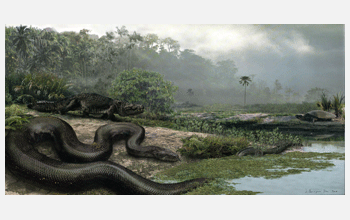Multimedia Gallery
Prehistoric Snake Found
Reconstruction of a 60 million-year-old tropical ecosystem based on fossils from the Cerrejon coal mine in Northern Columbia. The artist's rendering of the largest snake on record--a 45 foot Titanoboa cerrejonensis--shows its size. The boa likely spent much of its life in or near water. Also pictured is a dyrosaurid crocodyllian and giant side-necked turtle.
More about this Image
Fossils from a 60-million-year-old South American snake whose length and weight might make today's anacondas seem like garter snakes, were discovered in the Cerrejon coal mine in northern Colombia. Named Titanoboa cerrejonensis by its discoverers, Smithsonian Tropical Research Institute geologist Carlos Jaramillo and University of Florida vertebrate paleontologist Jonathan Bloch, the size of the snake's vertebrae suggest it weighed 1,140 kilograms (2,500 pounds) and measured 13 meters (42.7 feet) from nose to tail tip. Such a large size had scientists wondering how warm would the Earth have to have been to support a body of this size?
"Scientists have long known of a rough correlation between a period or epoch's temperature and the size of its poikilotherms (cold-blooded creatures)," said Paul Filmer, program director in the National Science Foundation (NSF)'s Division of Earth Sciences, which co-funded the research (grant DEB 07-33725). "As Earth's temperature increases, so does the upper size limit on poikilotherms."
Paleontologist Jason Head of the University of Toronto made an estimate of Earth's temperature 58 to 60 million years ago in an area encompassed by modern-day Colombia. Head estimated that a snake of Titanoboa's size would have required an average annual temperature of 30 to 34 degrees Celsius (86 to 93 Fahrenheit) to survive. By comparison, the average yearly temperature of today's Cartagena, a Colombian coastal city, is about 83 degrees Fahrenheit.
"Tropical ecosystems of South America were surprisingly different 60 million years ago," said Bloch. "It was a rainforest, like today, but it was even hotter and the cold-blooded reptiles were substantially larger. The result was, among other things, the largest snakes the world has ever seen." To read more about the discovery, see the NSF press release, "Prehistoric Fossil Snake is Largest on Record." (Date of Image: December 2008)
Credit: Jason Bourque, Florida Museum of Natural History
See other images like this on your iPhone or iPad download NSF Science Zone on the Apple App Store.
Images and other media in the National Science Foundation Multimedia Gallery are available for use in print and electronic material by NSF employees, members of the media, university staff, teachers and the general public. All media in the gallery are intended for personal, educational and nonprofit/non-commercial use only.
Images credited to the National Science Foundation, a federal agency, are in the public domain. The images were created by employees of the United States Government as part of their official duties or prepared by contractors as "works for hire" for NSF. You may freely use NSF-credited images and, at your discretion, credit NSF with a "Courtesy: National Science Foundation" notation.
Additional information about general usage can be found in Conditions.
Also Available:
Download the high-resolution JPG version of the image. (1.4 MB)
Use your mouse to right-click (Mac users may need to Ctrl-click) the link above and choose the option that will save the file or target to your computer.



